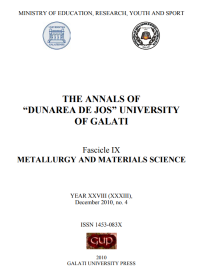Corrosion Resistance in Neutral Saline Fog of the Composites Cu-Mo Obtained by PVD Method
Abstract
The basic materials used for electrical contacts, which may be available economically, are the Cu-Mo based composites obtained by the method of electron flow at high temperatures under vacuum.
Cu-Mo (12% max. Mo) composite materials are produced by simultaneous evaporation from separate Cu and Mo crucibles with subsequent condensation of the vapor flow on an OL-37 steel layer of 15 to 20 mm thickness and 800 mm diameter. The surface of the disk-support on which condensation of the vapor flow takes place was machined until a roughness of Ra =0.63 was obtained.
Analysis of chemical composition and structure of composites based on copper and molybdenum content allowed determination of the variation of these elements from layer to layer (of up to 20-25% to 4-5 mas.) and the distribution gradient of these elements in the layers.
The Cu-Mo composites produced by PVD method were introduced in the room and tested in neutral saline fog exposure time of 100h. Cu-Mo composites, obtained by PVD method, have a fairly good corrosion resistance, at Mo concentrations ranging from 8% to 12 % of the surface do not present oxides and the concentrations of Mo between 1,2 to 6% area are covered with oxide.
Downloads
References
[2]. M.I. Grechanyuk, V.O. Osokin and I.B. Afanasiev, Composite materials for electric materials and obtaining method, Pat. 34875 Ukraina. MPK C23C/20, Bul. Nr.12, 2002.
[3]. B.A. Movcian, V.A. Osokin, L.V. Pusecinicova, N.I. Grechanyuk, Electron flow evaporation and copper condensation using intermediary creuset, Issues of power metallurgy, Nr. 3, 1991, p. 58-61.
[4]. V.G. Grechanyuk, L. Orac, V.A. Denisenko, Studies and research on mechanical properties and the influence of structural defects for the Cu-Mo composite materials obtained using the PVD metod, Proceedings GEOENV 2008, Geoenvironment and Geotechnics, Publisher by Heliotopus Conferences, ISBN 978-960-6746-01-7, Millos, Greece, 2008.
[5]. V.G. Grechanyuk, V.A. Denisenco, L. Orac Structurre and corrosive firmness of composition materials on basis of copper and molybdenum electron beam technology metod, The Annals of ‘Dunărea de Jos’ University of Galaţi, Fascicle IX Metallurgy and Material Science,Vol. Nr. 1, 2007.
[6]. V.G. Grechanyuk, V.A. Denisenko, I.F. Rudenko, L. Orac, Anticorrosive stability of cooper-molybdenum composites for electrical contacts, Electrical contacts and electrode, Kiev I.N. Frantevicia NAN Ukraina, 2008, p. 129-133.



